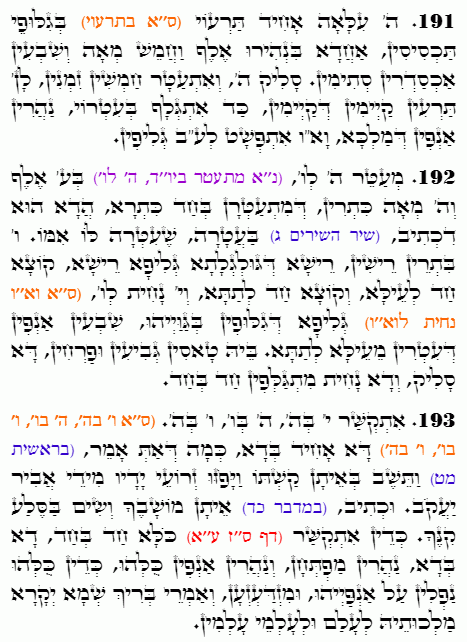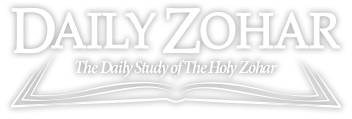Daily Zohar # 4636 – Acharei Mot – The arms of his hands were made strong
Daily Zohar 4636

Hebrew translation:
192. מְעַטֶּרֶת ה’ אֶת ו’ (נ”א מִתְעַטֶּר ביו”ד, ה’ לו’) בְּשִׁבְעִים אֶלֶף וַחֲמֵשׁ מֵאוֹת כְּתָרִים שֶׁמִּתְעַטְּרִים בְּכֶתֶר אֶחָד. זֶהוּ שֶׁכָּתוּב (שם ג) בָּעֲטָרָה שֶׁעִטְּרָה לּוֹ אִמּוֹ. ו’ בִּשְׁנֵי רָאשִׁים, רֹאשׁ הַגֻּלְגֹּלֶת חָקוּק הָרֹאשׁ שֶׁלּוֹ, קוֹץ אֶחָד לְמַעְלָה וְקוֹץ אֶחָד לְמַטָּה, וְי’ יוֹרֶדֶת לְו’, חֲקִיקַת הַחֲקִיקוֹת בְּתוֹכָם, שִׁבְעִים פָּנִים שֶׁל עֲטָרוֹת מִמַּעְלָה לְמַטָּה. בּוֹ טָסִים גְּבִיעִים וּפְרָחִים, זֶה עוֹלֶה וְזֶה יוֹרֵד, וְנֶחְקָקִים אֶחָד עִם אֶחָד.
193. נִקְשֶׁרֶת י’ עִם ה’, ה’ עִם ו’, ו’ עִם ה’ (ו’ בְּה’, ה’ בְּו’, ו’ בְּו’, ו’ בְּה’). זֶה אָחוּז בָּזֶה, כְּמוֹ שֶׁנֶּאֱמַר (בראשית מט) וַתֵּשֶׁב בְּאֵיתָן קַשְׁתּוֹ וַיָּפֹזּוּ זְרוֹעֵי יָדָיו מִידֵי אֲבִיר יַעֲקֹב. וְכָתוּב, (במדבר כד) אֵיתָן מוֹשָׁבֶךָ וְשִׂים בַּסֶּלַע קִנֶּךָ. אָז הַכֹּל מִתְקַשֵּׁר אֶחָד עִם אֶחָד, זֶה עִם זֶה, מְאִירִים הַמַּפְתְּחוֹת וּמְאִירִים כָּל הַפָּנִים. אָז כֻּלָּם נוֹפְלִים עַל פְּנֵיהֶם וּמִזְדַּעְזְעִים וְאוֹמְרִים: בָּרוּךְ שֵׁם כְּבוֹד מַלְכוּתוֹ לְעוֹלָם וּלְעוֹלְמֵי עוֹלָמִים.
.
Zohar Acharei Mot
Continued from previous DZ
#191
Now, it explains the three lines within Binah and how each one is connected to the Yud (י), which represents Chokmah. It says that the upper Heh (ה) of the YHVH, which is Binah, holds onto its gates, which are the 50 gates of Binah, through inscribed arrangements. This refers to the elevation of Malchut to Binah and its subsequent descent back to its place. This process creates the three lines within Binah. At that point, Binah holds the light of 1,570 hidden colonnades.
The number 1,000 corresponds to Chokmah, representing the right line. The number 500 corresponds to Binah, representing the left line. The number 70 corresponds to Da’at, which is the middle line. Since these Mochin are the roots of the light of Chokmah, they are called colonnades, which are open in all directions. However, because this is not the place of their full illumination—since in Binah, Chessed rules, not Chokmah—they are considered hidden colonnades that will only be fully revealed in Malchut, where Chokmah rules.
All three lines of these are the Chokmah within Binah, and the right line of Binah contains all three lines. Afterward, the ה Heh, which represents Binah, rises and crowns itself fifty times, corresponding to the 50 gates of Binah, which are the foundation of all existence. These 50 gates represent the Binah within Binah, which is the left line, the root of all Mochin called “existence.” When Binah is engraved in its crowns—referring to its two crowns, which are the secret of her level of Da’at—then the face of the King, Zeir Anpin, is illuminated. This is because all of the lights of Zeir Anpin are drawn from these two crowns in the secret of “תלת נפקי מחד, חד בתלת קיימא” “three come out of one, and one is established in three.” The Vav (ו) then extends through these lights to form 72 engravings corresponding to the 72 names. The Vav represents the six sefirot (sides, קצוות) (Chessed, Gevurah, Tiferet, Netzach, Hod, Yessod), and in each end, 12 aspects shine. These 12 aspects are Chokmah, Binah, Tiferet, and Malchut, with three lines within each. Six times 12 is 72. And thus, it explains how the three lines of Chokmah, Binah, and Da’at of Binah are connected to Chokmah.
#192
After the three lines of Chokmah, Binah, and Da’at within Binah are expanded, represented by the letter Heh (ה), they crown the Vav (ו) with 70,000 and 500 crowns. This refers to the secret of Chokhmah, Chessed, Gevurah, Tiferet, Netzach, Hod, and Yessod, which are the right line, Chokmah, Gevurah, Tiferet, Netzach, and Hod of Binah are the secret of the 500, which are the left line, crowned by a single crown—Da’at—which unifies and includes them all. This is the meaning of
Songs 3:11
“צְאֶינָה וּרְאֶינָה בְּנוֹת צִיּוֹן בַּמֶּלֶךְ שְׁלֹמֹה בָּעֲטָרָה שֶׁעִטְּרָה לּוֹ אִמּוֹ בְּיוֹם חֲתֻנָּתוֹ וּבְיוֹם שִׂמְחַת לִבּוֹ.”
“Go forth, O daughters of Zion, And see King Solomon with the crown With which his mother crowned him On the day of his wedding, The day of the gladness of his heart.”
“his mother crowned him” is Binah, the mother of the Vav, Zeir Anpin.
Thus, the Vav is engraved with two heads: one representing Chokmah and the other representing Binah. Therefore, the Vav is written with two Tags (prones) on its top: one crown above, symbolizing Chokmah, and one below, symbolizing Binah. The Yud, which represents Chokmah, descends into the Vav, meaning that the Vav (Zeir Anpin) is connected to the Yud (Chokmah), just as it is connected to the Heh (Binah).
This engraving of all engravings is the middle line between the two heads, which is the 70 faces that crown it from above to below—referring to Da’at, which extends from above to below. This Da’at consists of Chessed, Gevurah, Tiferet, Netzach, Hod, Yessod, and Malchut, each one containing ten aspects, totaling 70.
Within it, hover cups and flowers. Da’at is divided into two parts: the lights of the right, called “גְּבִיעִים” “cups,” and the lights of the left, called “פְרָחִים” “flowers.” The flowers ascend, referring to the lights of the left, which illuminate only from below to above, while the cups descend, referring to the lights of the right, which bestow from above to below. They are engraved one within the other, as the lights of the right are included in the lights of the left.
#193
The Yud is connected to the Heh, the Heh to the Vav, and the Vav to the final Heh, all interlocked with one another. That is, the Vav, which represents Zeir Anpin, is connected to the Heh, which represents Malchut. This is as it is written:
Genesis 49:24
“וַתֵּשֶׁב בְּאֵיתָן קַשְׁתּוֹ וַיָּפֹזּוּ זְרֹעֵי יָדָיו מִידֵי אֲבִיר יַעֲקֹב מִשָּׁם רֹעֶה אֶבֶן יִשְׂרָאֵל.”
“But his bow remained in strength, And the arms of his hands were made strong By the hands of the Mighty God of Jacob, from there is the Shepherd, the Stone of Israel.”
The term “strength” (איתן) refers to Yessod, and “his bow” (קשתו) refers to Malchut. Thus, we see that the Yessod of Zeir Anpin is connected to Malchut. And it is further written: “אֵיתָן מוֹשָׁבֶךָ וְשִׂים בַּסֶּלַע קִנֶּךָ” “Your dwelling is in strength, and make your nest in the rock.” Here, “strength” (איתן) refers to Yessod, and “the rock” (סלע) refers to Malchut.
At this point, everything is interconnected, one to the other, with light emanating from Chokmah illuminating the keys, which are all aspects of the middle line. The middle line is called a “key” because it opens the light of Chokmah by harmonizing the right and left lines. All the faces shine, which refers to the 70 faces mentioned earlier. At this time, all the beings “fall on their faces,” which means they conceal their faces, not seeking to draw the light of the upper three of Chokmah from above to below, a form of light that was diminished by the middle line. They tremble due to the judgments that are revealed with the light of Chokmah, and they proclaim: “בָּרוּךְ שֵׁם כְּבוֹד מַלְכוּתוֹ לְעוֹלָם וּלְעוֹלְמֵי עוֹלָמִים” “Blessed be the name of His glorious kingdom forever and ever.”
{||}

 Previous: Acharei Mot
Previous: Acharei Mot

